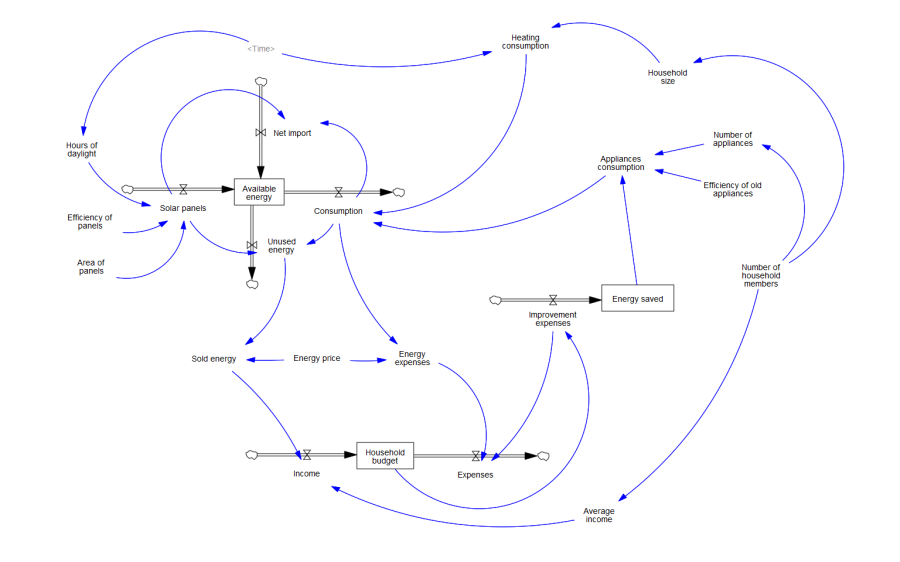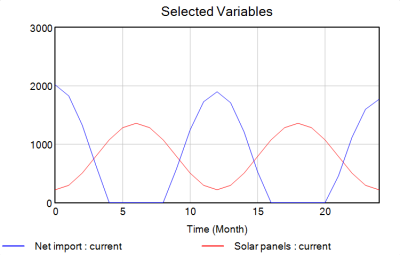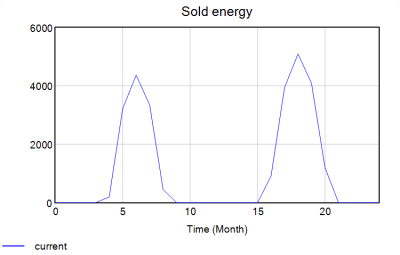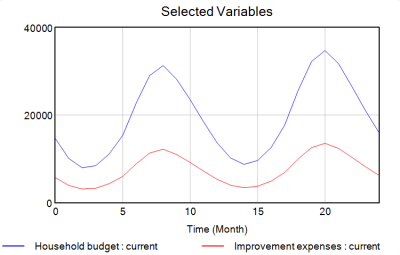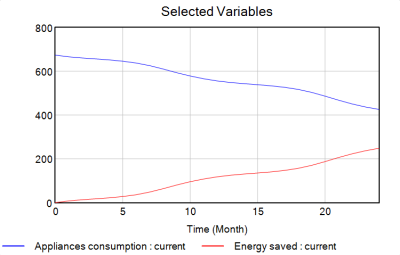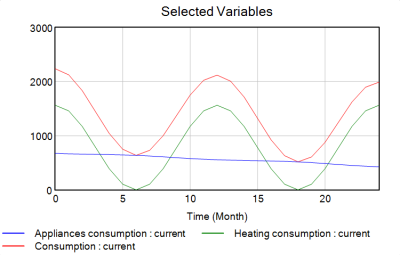Household electricity consumption
Contents
- 1 Problem definition
- 2 Method
- 3 Model
- 4 Variables
- 4.1 Appliances consumption
- 4.2 Area of panels
- 4.3 Available energy
- 4.4 Average income
- 4.5 Consumption
- 4.6 Efficiency of old appliances
- 4.7 Efficiency of panels
- 4.8 Energy expenses
- 4.9 Energy price
- 4.10 Energy saved
- 4.11 Expenses
- 4.12 Heating consumption
- 4.13 Hours of daylight
- 4.14 Household budget
- 4.15 Household size
- 4.16 Improvement expenses
- 4.17 Income
- 4.18 Net import
- 4.19 Number of appliances
- 4.20 Number of household members
- 4.21 Solar panels
- 4.22 Sold energy
- 4.23 Time
- 4.24 Unused energy
- 5 Results
- 6 Conclusion
- 7 Code
- 8 References
Problem definition
The problem of household electricity consumption is a significant concern as it affects the household's budget and the environment. The increasing demand for energy and the rise in electricity costs have made it essential for families to understand and manage their electricity consumption. Households consume electricity for various purposes, such as lighting, heating, cooling, and running appliances. Moreover, the consumption of electricity in households contributes to the generation of greenhouse gases responsible for climate change. Therefore, reducing household electricity consumption is not only important for the household's budget but also for the environment.
The goal of simulating household electric energy consumption is to model and predict a home's electricity usage. This can help individuals and families understand their energy consumption patterns, identify ways to reduce their energy use and help utilities and energy companies predict and plan for electricity demand.
Method
The dynamic behavior of the simulated system led to the selection of the Vensim modeling software.
Model
The model represents a household with a hybrid solar system. The hybrid system combines solar photovoltaic panels and a traditional connection to an electrical grid. When solar panels cannot supply the household itself, the grid power is imported. Electricity is used to power household appliances and heating of the building. Another crucial part of the model is the household budget dedicated to covering energy expenses and appliances improvement expenses.
Variables
Appliances consumption
Appliance consumption represents the total consumption of all household appliances. It's calculated by multiplying the number of appliances by the efficiency of old appliances minus the energy saved by investing in the improvement of the appliances.
= Efficiency of old appliances*Number of appliances-Energy saved Units: kWh
Area of panels
Represents the total area covered by solar panels. The default value is 30. This value can be adjusted based on the household space available.
= 30 Units: m2
Available energy
Available energy represents the energy provided by both solar panels and the power grid. Our system doesn't have a battery to store redundant energy. Thus, if there is any unused energy, it's immediately sold to an energy provider. This variable could be easily tweaked to represent the power system with an accumulator.
= INTEG (Net import+Solar panels-Consumption-Unused energy, 0) Units: kWh
Average income
The value of average income is based on household income data from ČSÚ’s. [1]
= (18342.2)*Number of household members Units: CZK
Consumption
Total household electricity consumption created by heating and appliances.
= Appliances consumption+Heating consumption Units: kWh
Efficiency of old appliances
Represents average monthly energy consumption of one piece of inefficient appliance. The value was calculated as an average of most used home appliances with the worst EU energy label rating. The data for calculation is available in source section.
= 43.2 Units: kWh
Efficiency of panels
The efficiency of installed solar panels – how much of the solar energy the panel can use. The most commercial panels have efficiencies from 15% to 20% .[2] Median of these values is used.
= 0.175
Energy expenses
Value of monthly energy expenses.
= Consumption*Energy price Units: CZK
Energy price
Price of 1 kWh provided by ČEZ. [3]
= 6.05 Units: CZK
Energy saved
kWh saved by investing in the upgrade of appliances. The value is calculated as an improvement expenses divided by the average price of updating the efficiency of the appliances by 1 kWh. Calculation of this value is available in the code section.
= INTEG (Improvement expenses/730.6,0) Units: kWh
Expenses
Total household expenses for energy and appliance improvement.
= Energy expenses+Improvement expenses Unit: CZK
Heating consumption
The Czech energy management act (vyhláška č. 78/2013 Sb.) requires new houses to be built at least in energy category C. The particular value kWh/m2 required for heating depends on the house's shape, orientation, and glazing – it's between 40 – 90 kWh/m2 per year. When we take into consideration the seasonality (cons function) and median of 75kWh/m2 per year, we get this equitation:
= 10.83*((1+COS((Time-0)/12*2*3.14159 ))/2)*Household size Units: kWh
Hours of daylight
The hours of sunshine per month in Prague. [4] Seasonality considered (COS function) with the peak during summer.
= 42+217*((1+COS((Time-6)/12*2*3.14159 ))/2) Units: hours
Household budget
Expenses dedicated to electricity and appliance improvement.
= INTEG (Income-Expenses,14673.7) Units: CZK
Household size
Based on ČSÚ data, the average household size is 36,1 m2 per person. [5]
= Number of household members*36.1 Units: m2
Improvement expenses
Based on the ČSÚ data, the appliance expenses create on average 39 % of the budget for electricity and appliance improvement. [5]
= Household budget*0.39 Units: CZK
Income
Based on the ČSÚ data, the expenses dedicated to electricity and appliance improvement create 20 % of income [5]
= Average income*0.2+Sold energy Units: CZK
Net import
Amount of energy imported from the power grid. Energy is imported only when there is not enough energy from solar panels.
= IF THEN ELSE( Solar panels>Consumption , 0 , Consumption-Solar panels ) Units: kWh
Number of appliances
The number of appliance is based on the number of household members. [6]
= IF THEN ELSE(Number of household members =1, 10.6 , IF THEN ELSE(Number of household members = 2, 13.8 , IF THEN ELSE(Number of household members = 3, 14.7 , IF THEN ELSE(Number of household members=4,15.6 , IF THEN ELSE(Number of household members =5, 16.5 , 17.5) ) ) ) )
Number of household members
The default number of family members.
= 4
Solar panels
The total amount of energy produced by solar panels.
= Area of panels*Efficiency of panels*Hours of daylight Units: kWh
Sold energy
Amount of money received for the sold energy.
= Unused energy*Energy price Units: CZK
Time
The time step for the simulation.
Units: Month
Unused energy
Amount of unused energy from solar panels.
= IF THEN ELSE(Solar panels>Consumption, Solar panels-Consumption , 0 ) Units: kWh
Results
Hybrid solar system
We can see a reasonable interpretation of the hybrid solar system. There is a clear seasonality when the solar panel does not output enough power during the colder, darker month, and energy needs to be imported from the grid. There's also a slight downward trend because of the appliance's upgrades.
Energy sold
We can see that there is quite a surplus of solar-generated energy during the summer months. In the peak of the first year, in the 6th month, the value of sold energy is 4353,5 CZK.
Household budget
The amount of energy sold has a positive effect on the household budget and, as a result, also affects the budget dedicated to improving the appliances.
Appliances consumption and saved energy
We can see that the more household invests in appliance upgrades, the more energy can save and reduce total appliance consumption.
Total consumption
Heating consumption quite drastically affects the household's total consumption. It's not a surprise because heating is one of the most significant household expenses. [5] The appliance consumption is reducing overall consumption down over time.
Conclusion
The model provides a realistic results. We can see the effect of solar panel production during seasons and overall expense reduction after investment in appliance upgrades. By changing the household information (solar panel, house, members, income data) it can be used as a tool for practical assumption of household budget and it's energy consumption.
However, there are still limitations in the model. The seasonality modeling in Vensim is quite limited. The COS function creates a seasonality curve, and it's better than a linear function, but it's still far from perfect.
The appliance upgrade mechanic is simplified by using average consumption per appliance. In future models, the appliances could be split into dedicated devices to provide a more detailed overview of the consumption behavior.
The model can also be easily changed to an off-grid solar system with a dedicated battery. This would provide insight into different type of solar panel solution.
Code
Household electricity consumption Vensim model
Dataset for appliance calculations
References
- ↑ Příjmy a životní podmínky domácností - 2021 [Internet]. Příjmy a životní podmínky domácností - 2021. [cited 2023 Jan 21]. Available from: https://www.czso.cz/csu/czso/prijmy-a-zivotni-podminky-domacnosti-r4hlvpcwox.
- ↑ University of Mitchigan. Photovoltaic Energy Factsheet [Internet]. Center for Sustainable Systems. [cited 2023 Jan 20]. Available from: https://css.umich.edu/publications/factsheets/energy/photovoltaic-energy-factsheet.
- ↑ www.fg.cz, 2023 FF a s. Ceny | Skupina ČEZ [Internet]. Skupina ČEZ - Produktová sekce. [cited 2023 Jan 21]. Available from: http://www.cez.cz/cs/ceny.
- ↑ Total Hours of Sunshine - Prague - Climate Robot Czech Republic [Internet]. [cited 2023 Jan 19]. Available from: https://www.weatheronline.co.uk/weather/maps/city?FMM=1&FYY=2018&LMM=12&LYY=2022&WMO=11518&CONT=euro®ION=0001&LAND=CZ&ART=SOS&R=0&NOREGION=0&LEVEL=162&LANG=en&MOD=tab.
- ↑ 5.0 5.1 5.2 5.3 Spotřební výdaje domácností - 2021 [Internet]. Spotřební výdaje domácností - 2021. [cited 2023 Jan 20]. Available from: https://www.czso.cz/csu/czso/spotrebni-vydaje-domacnosti-2021.
- ↑ Won AN, Hong WH. A Survey on Ownership of Home Appliances and Electric Energy Consumption Status According to the Number of Household Member. Applied Mechanics and Materials. 2014;672–674:2165–2168.
